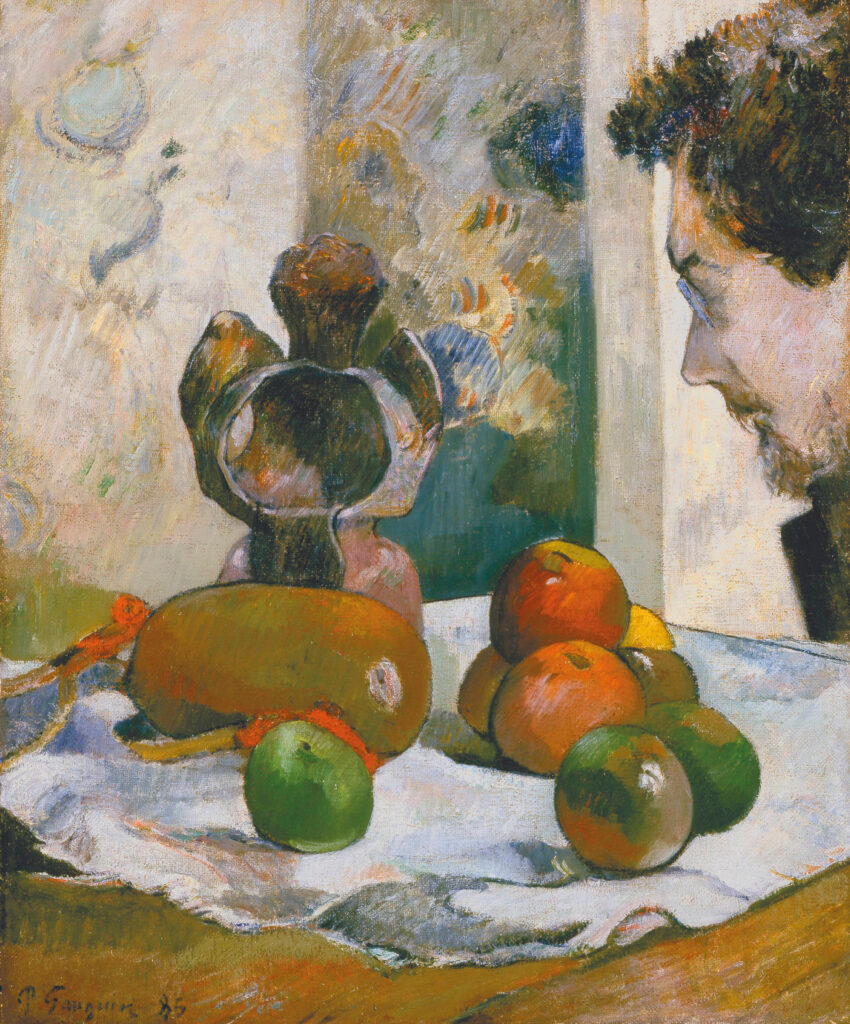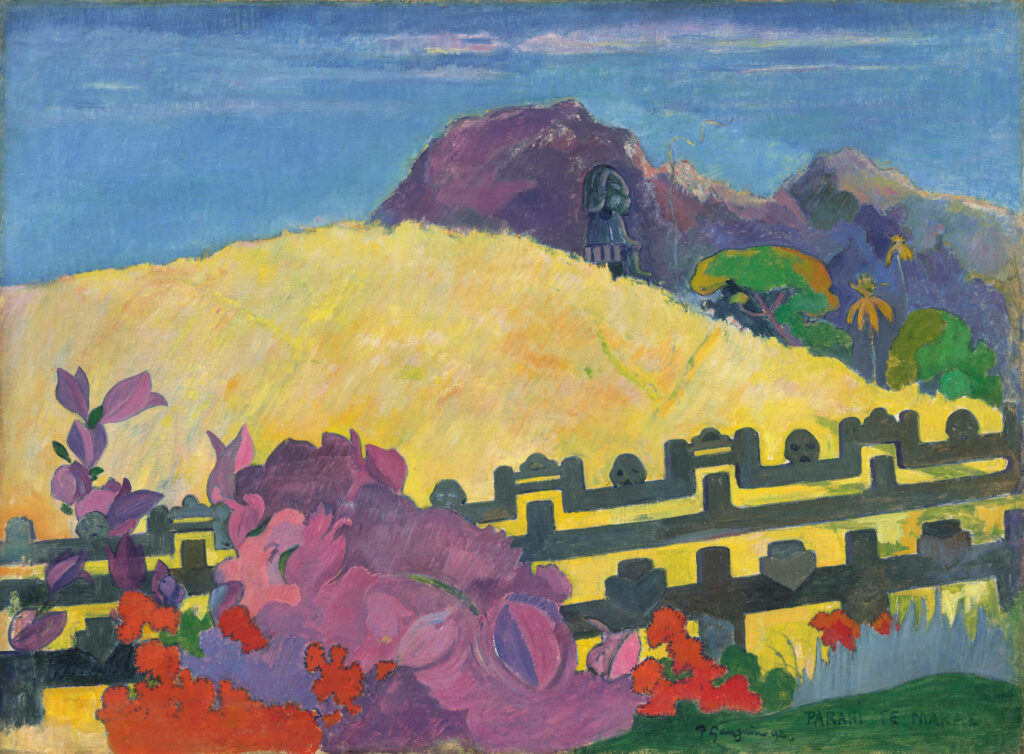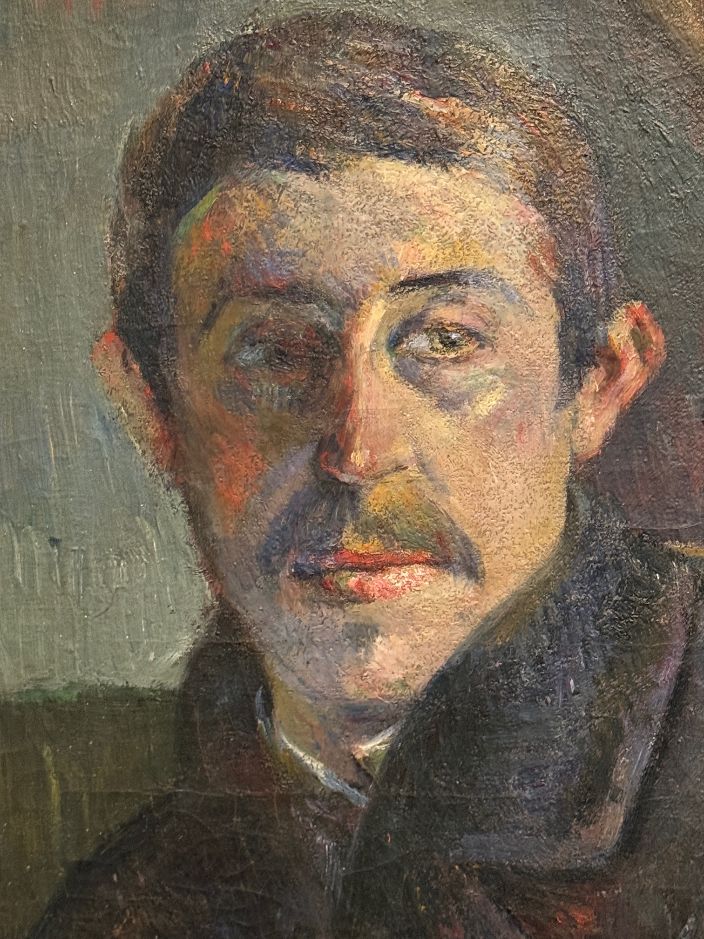Paul Gauguin (1848 – 1903) is usually referred to as a French painter, but that is deceptive. While born in France, his grandmother was a Peruvian-born Spanish aristocrat. Just one year old, he travelled with his parents to Peru, his father dying on the long voyage. For the next 6 years he lived in Peru, which formed the basis of his yearning for a primitive lifestyle that he returned to in his final years living in Polynesia. When the young Gauguin arrived back in Paris, he couldn’t speak French, describing himself as a “wild thing from Peru.” A new blockbuster exhibit at the Museum of Fine Arts in Houston brings together a dazzling array of artwork this wild thing created throughout his life.
Gauguin began painting in 1873, when he was 25. Initially affluent at his job in the Paris stock exchange, he went broke in 1883 and decided to leave France for Copenhagen, Denmark. Even though Gauguin did not like Denmark (he thought it “vile”), his time there from November 1884-May 1885 “stimulated him to form an independent opinion of his art which, by his own admission, was rather ‘one of thought than of acquired technique.’” [quote from pg.28 of the book Gauguin by N. Brodskaya (2011)] There are 5 Copenhagen items in this exhibit, but they are not displayed together, so that Gauguin’s important time in Copenhagen will pass nearly unnoticed by most visitors here.
Two years ago, I attended a small exhibit of his paintings at the Glyptotek in Copenhagen; sadly, none of the Gauguin paintings held by this important museum are included in the Houston show. The focal point of the exhibition was the newly acquired painting La neige à Copenhague (Snow in Copenhagen; 1884). It dates from the period when Gauguin and his wife Mette and their children lived in a ground-floor flat at 105, Gl. Kongevej in Copenhagen; the view is likely from that building. The work is one of the first landscapes he painted in that city, and it’s a real treasure. One that is on display here is Still Life in an Interior, Copenhagen. It includes a large Norwegian tankard, depicted in orange. The very same tankard sits beside a work Gauguin did in late 1884, after he and his son Clovis moved back to France, in Rouen (Gauguin left his wife behind, never seeing her again). Did he at least take the tankard with him, one wonders? Did his wife mind? In any case, this work entitled Clovis Sleeping is unlike anything else Gauguin created, with sparks of imagination in the air above Clovis and the tankard that hint of plants and animals from a child’s dream. A third painting, from the Glasgow Life Museum, is a landscape of a park in Copenhagen. In this work, the museum information tells us, it shows him “investigating fresh, luminous colour and experimenting with bold, multidirectional brushwork to convey a sense of life and movement.” An important and beautiful work.
There are two other items from his time in Copenhagen. One is a fan, but its place of origin is unfortunately elided from the description in the exhibit. This is where the excellent 288-page catalogue (Gauguin’s World by Henri Loyrette, former Director of The Louvre) makes its presence felt. In a timeline of Gauguin’s life, we learn that the fan, complete with the motif of a ballet dancer taken from a composition by Degas, comes from his time in Copenhagen. He “explores a new direction in carving” at this time, Loyrette writes. Gauguin’s first self-portrait, on loan from the Kimbell Art Museum in Fort Worth, was also done in Copenhagen. Curiously, this fact is included in the exhibit, but omitted in the catalogue! Not gathering these five pieces together to highlight Gauguin’s brief but formative time in Copenhagen is a missed opportunity in an otherwise superlatively-displayed exhibit.
Interest in Gauguin is exceptionally high these days. Part artist’s manifesto, part memoir, and part catty burn-book, Gauguin’s Avant et après resurfaced several years ago after having been missing for a century. In the Courtauld Institute’s collection since 2020, the visually stunning manuscript features Gauguin’s graceful penmanship interspersed with illustrations and is bookended by Japanese ukiyo-e works and a Dürer print that the artist pasted in. A new Gauguin biography has just hit the bookstores: Sue Prideaux draws from that long-lost material to retell the artist’s near-mythic life, from Peru to the Marquesas Islands and everywhere in between—including Arles, where, it is speculated, Gauguin may have had something to do with Van Gogh’s self-mutilation of his ear. The two artists lived together in Arles in 1888. Alas, Gauguin’s work, showing Van Gogh painting Sunflowers, is not on view in Houston (it resides in the Van Gogh Museum in Amsterdam, which did loan the 1894 painting Paris in the Snow, and the amazing 1884 Clovis Sleeping, for this exhibit).
This exhibit in Houston comes hard on the heels of another major Gauguin exhibit in London. That one concentrated on his portraiture: thankfully, several of the works on display there are in this show. One (shown here, from 1886) is of his friend Charles Laval, who merely inserts his face into the painting to gaze in wonder and admiration at one of Gauguin’s ceramics, many examples of which are on display. Lighting is rarely a problem at such a major exhibit, but his famous 1890 painting ‘Portrait of the artist with the yellow Christ’ suffers here: a shadow cast by the upper portion of the frame goes across the top inch of the painting, directly across the upper face of Christ.

I have already mentioned one deficiency in the printed descriptions in the exhibit; another one that caught my eye was the information for Street in Tahiti (1891). It draws attention to a woman huddled on the left, but she is actually on the right. Much of this exhibit is focused on his Polynesian paintings. The most intriguing one for me is The Sacred Mountain from 1892. Atop a yellow mountain is an ancient sculpture, which is inspired by figures on Easter Island. The fence is based on a design of a carved bone ear ornament from the Marquesas Islands; only an inch wide, one of these is also on display. The landscape is thus a pastiche of colours and cultural influences that was not found anywhere on Earth except the mind of Gauguin. Not surprisingly, Gauguin was not to everyone’s tastes. A contemporary symbolist critic, Alphonse Germain, characterised the excessive deformations in Gauguin’s works as monstrous, savage and puerile. Visit Houston and see what all the fuss was about. A tremendous showing of an amazingly influential artist, this is not to be missed!

This exhibit was first shown in Canberra, Australia. There are 20 works different here, a dozen of which are unique to the Houston exhibit. In all, there are 69 lenders, including the McNay Art Museum of San Antonio and several private collections, including at least one in Texas. The international scope of the lenders is astonishing, with entries from Canada, Japan, Denmark, Spain, Belgium, Germany, Switzerland, Tahiti, Serbia, the UK., Australia and The Louvre Dubai.
Gauguin’s World is on display at the MFA in Houston until Feb. 16, 2025.
The catalogue is highly recommended; it includes well-reproduced colour images of the entire exhibit, and informative essays by several Gauguin art experts.
Those who want to see more of the artist and his life should visit the website www.gauguin.org
Images: lead photo: detail from his first self-portrait, done while in Copenhagen in 1885. Kimbell Art Museum
Still life with profile of Laval (1886). Indianapolis Museum of Art.
The Sacred Mountain (1892). Philadelphia Museum of Art.
